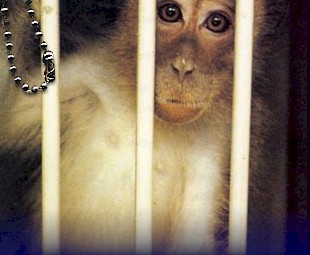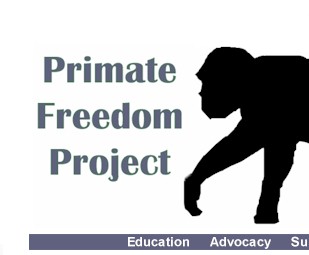






|
||||||||||||||||||||||||||||||||||||||||||||||||||||||||||||||||||||||||||||||||||||||||||||||||||||||||||||||||||||||||||||||||||||||||||||||||||||||||||||||||||||||||||||||||||||||||||||||||||||||||||||||||||||||||||||||||||||||||||||||||||||||||||||||||||||||||||||||||||||||||||||||||||||||||||||||||||||||||||||||||||||||||||||||||||||||||||||||||||||||||||
WNPRC and Public Relations
The Wisconsin Regional Primate Research Center (WRPRC) refuses
to comment on the status and fate of individual monkeys. Hundreds
of US citizens have written to WRPRC with questions concerning particular
monkeys (by serial number), and have received either arrogant silence
or a pat response in the most general terms possible. (See public
relations director, Jordana Lenon's
reply to one inquiry.) Now, WRPRC has produced what must be the second most blatant attempt
to mislead the public regarding the care and concern for the monkeys
they routinely hurt and kill. [The first most blatant set of orchestrated
lies can be read about in the article: The
Vilas Monkey Debacle.] This new attempt to plant doubt in the
minds of caring, and usually trusting, people appears to be a result
of the many queries they have been receiving about their acts of
cruelty and their ethical failure. The new
page must be seen to understand the "sweetness" it
tries to present. [Since the time of this article's first appearance,
the page has been toned down, apparently in response to these criticisms.]
It appears to target elementary school students, and is replete
with red apples, that are easy to confuse as hearts or valentines,
decorating the screen. Whether the page will remain online remains
to be seen, but it is an amazing artifact of either self-delusion
or public deception in any event. The rest of this article deals with the center's allegations and
misrepresentations one at a time. The start of the page is broken
into five paragraphs. Paragraph One: The Wisconsin Regional Primate Research Center is home to about
1,000 rhesus monkeys. This Old World primate species is native to
eastern Afghanistan, Pakistan, India, Nepal, and parts of China
and Southeast Asia. The center has its own breeding colony and does
not import animals from the wild. The number of monkeys at Wisconsin seems to be something the center
wishes to keep hidden for some bizarre reason. When the mood strikes
them they decide not to mention the other 500 monkeys at the Harlow
Primate Psychology Lab only twenty feet away. Sometimes they argue
that the facility is not a part of WRPRC, but the foot traffic,
the traffic in monkeys, and the traffic in researchers between the
buildings belie any real distinction. The comment about imports may be true at this moment in time, but
the comment is not a policy. There is no moratorium on imports,
and no reason to assume that the center will not invent a need tomorrow,
or even later today, to begin imports afresh. The institution's
actual attitude toward importing monkeys and an idea of how such
animals might be treated is evident from the facility's recent divestment
of three colonies of macaques. The colony of stumptail macaques included the oldest known stumptail
monkey. She had been wild caught. The other two colonies were rhesus
monkeys and many of them were direct descendants of the last rhesus
monkeys to be exported from India. The stumptail macaques were neutered
and sent to a facility in San Antonio that the Primate Center had
deemed unsuitable only months before when anti cruelty activists
had announced that the two rhesus monkey colonies could be moved
there. But, instead, WRPRC sent the two rhesus colonies to Tulane University
for use in infectious disease studies. The old stumptail monkey
died after being moved. All three colonies had been housed at the
county zoo for decades. There were loved by the community; they
were screwed by the the University of Wisconsin, the National Institutes
of Health, and the Wisconsin Regional Primate Research Center. Paragraph Two: The center has an active breeding colony, a colony of older
monkeys for studies related to aging, and a general research colony
for other projects. All research is conducted under strict compliance
with the Animal Welfare Act for the humane care and use of laboratory
animals. This is true and simultaneously misleading. Most federally funded
laboratories are required to comply with the Animal Welfare Act
(AWA). But the assertion that the AWA has bearing on the humane
care and use of animals in laboratories is not borne out by a close
examination of the law or the behavior of the facilities it is purported
to regulate. In defense of WRPRC, however, it should be noted that
their statement has become a mantra for essentially all animal labs
and everyone recognizes its simple and pure propaganda. It was probably
impossible for WRPRC not to have mentioned it here - they are conditioned
to recite without thought. And for a window into the colony of older monkeys, read Piotr's
story. Why use rhesus monkeys? Rhesus monkeys share about 93 percent of their genes with humans,
they are not endangered in the wild, and they adapt well to captive
housing. Research with rhesus monkeys and other nonhuman primates
tells us a great deal about primate biology. In addition, animal
studies can be much more controlled and the results more consistent
than studies with humans. They did not answer their own question. "Why use rhesus monkeys?"
"Rhesus monkeys share about 93 percent of their genes with
humans." This answer implies that the other monkey species
held at the center are either better or worse models due to their
particular genetic difference from humans. Further, this suggests
that the center should be vivisecting chimpanzees who are over 98
percent genetically homologous to humans. . . . they are not endangered in the wild, But polio research, which most primate labs (including WRPRC) point
to as important evidence of the value of using monkeys, almost drove
rhesus monkeys to extinction in India. In fact, the Indian government's
refusal to allow the US to have any more monkeys (which were secretly
being killed in weapons experiments, even as the supply was dwindling
for polio studies) is what resulted in the creation of rhesus breeding
colonies in the US. This breeding program is what wedded the labs
to the rhesus monkey and assertions that there was ever a concern
for wild populations is utter nonsense. . . . they adapt well to captive housing. A germ of truth. Rhesus monkeys are not used because of genetic
similarity to humans - their use was in vogue long before we knew
anything about comparative genetics, which is quite recent knowledge.
Rhesus monkeys are used simply because they breed well in captivity.
Period. Any assertion to the contrary is poppycock. Research with rhesus monkeys and other nonhuman primates tells us a great deal about primate biology. This is true. Sadly for the monkeys being "sacrificed"
for you and me, their pain and suffering tells us nothing about
human biology. We are paying hundreds of millions of dollars every
year to harm monkeys in experiments that mean nothing to human health,
as if torturing them could be at all justified. In addition, animal studies can be much more controlled and the results more consistent than studies with humans. And this is why researchers love to experiment on animals. Not
because the results can be applied to humans, but because they can
be more controlled and are endlessly repeatable. In fact, the most
immediately applicable knowledge about human health comes from the
hard to control and replicate epidemiological studies such as the
recent finding by the Air Force that conclusively links Agent Orange
to disease in humans. [See the Ranch
Hand study.] Paragraph Four: As scientists develop more alternatives to using monkeys and
other animals in research, the numbers of animals needed for research
are declining. However, in many cases, neither a computer nor a
test tube can take the place of a living, complex biological system
for learning more about a disease or for testing a vaccine or therapy.
This is terribly misleading and an apparent attempt to mollify
those concerned with suffering. The number of primates used in the
United States has been static since 1973, when data began being
compiled by the Department of Agriculture. Over 50,000 primates
are used in US labs every year. The increased power of computers,
databases, mathematical modeling, and the strength of population
studies has done nothing to limit primate vivisection by even one
monkey. The primate center will be arguing for the continued need
to cut up monkeys even as the last vivisector is pushed out the
door to find honest work. And, WRPRC does not, and never has, produced a vaccine. This is
simple fear mongering. Paragraph Five: Rhesus research at the WRPRC Our rhesus monkeys are mainly involved in projects aimed at
making progress toward biomedical research goals-such as developing
a vaccine for AIDS, understanding reproductive and genetic disorders,
and answering other biological questions pertaining to primates.
While too numerous to list here, many of these projects are described
on our center's newsletter
and research
highlights Web pages. While too numerous to mention here, a snapshot of the projects
involving the center's monkeys is available at WRPRC.
What can be mentioned here, is the fact that AIDS is used by most
primate labs as their reason for being. If another disease received
more press coverage, that would be the disease WRPRC would tout.
In fact, the AIDS research conducted at the primate labs has been
a distinct failure. The labs study simian immunovirus (SIV) instead
of human immunovirus (HIV) in species, macaques, which are not affected
by HIV. The next part of WRPRC's rhesus page is divided into two sections:
"Frequently Asked Questions" and "A day in the life
. . ." Frequently Asked Questions How is the monkeys' care regulated? Regulations governing research animal care and use are very strict. The opposite is the case. Regulations governing animals consumed
in research does require some forms to be filled out; to the vivisectors,
this constitutes strict regulations. But the actual type
of experiments allowed to be performed on the animals is open ended.
This allows for every imagined cruelty. In all cases, our animal care practices either meet or exceed the requirements of the Federal Animal Welfare Act. But the Animal Welfare Act states:
Research projects and animal care policies are regularly reviewed by center personnel, university committees, and government officials on site visits, including unannounced inspections. The center personnel who review these policies are the same ones
being paid to experiment on the animals, who are paid by the facility,
who are financially beholden to the continuance of unbridled access
to experimental subjects. The notion that government officials have
any power to control the cruelty has been exposed repeatedly. Perhaps
the most blatant current example of this was the nightmare at the
Coulston Foundation in New Mexico. This is germane because the agencies
involved are the very same agencies WRPRC claims to be certifying
their own program and protecting the monkeys. The center must also provide an annual report of its activities
to the National Institutes of Health and the United States Congress
every year. The center is regularly reviewed and accredited by the
American Association for the Accreditation of Laboratory and Animal
Care - International (AAALAC-I). Laboratories claim that AAALAC certification is a clear indication
that the facility is complying with federal law and doing an outstanding
job of attending to animal care. The AAALAC journal is essentially
a trade journal for the vivisection industry; AAALAC inspects its
accredited labs once every three years (a blue moon?), and accreditation
means nothing at all. Does the research hurt the monkeys? Much of our center's research is noninvasive-it does not harm
the animal physically or psychologically in any way. In a sense, this is good news. For years anti-cruelty advocates
have been arguing that psychological harm is invasive. The fact
that at least one primate lab concurs is evidence of, at least a
little, progress. The assertion that most of the research at the
center is not harmful is a simple lie. Of the approximately 45 researchers
using monkeys, at least 35 have projects underway which do seem
to harm the monkeys. Some of the others, while not harming monkeys
directly, are involved in cloning and reproductive studies intended
to produce monkeys who will be hurt. This typically involves blood, urine and tissue sampling for
hormone levels, blood cell counts and other biomarkers, just as
humans are tested in clinical settings. Once again, an attempt to mislead, this time by comparing apples
and oranges. Taking blood, urine, or tissue from a monkey is nothing
like doing this to a human in a clinical setting. Often, when these
tests are performed, (which can be daily) the monkeys are injected
with ketamine to paralyze them. Imagine your child first being paralyzed
before a blood sample is taken. The intense fear and resistance
is well known. Such testing helps us not only learn more about the animals' basic biological processes for research purposes, but also helps us take better care of the monkeys themselves. No one questions whether experiments on monkeys teaches scientists
about monkeys. The idea that the results are beneficial to the monkeys
stands starkly at odds with how the monkeys are actually treated. The monkeys must be treated humanely at all times. Such a statement is possible only when supported by massive self-delusion.
There is really no choice. Asserting otherwise would lead to self-damnation.
Introspection by vivisectors must be an exercise in self-justification
rather than an honest evaluation. If they undergo invasive surgery-to remove a tumor, deliver an infant by Cesarian section or test a new glaucoma therapy, for instance-anesthesia is always used, just as it is for human surgeries. But this suggests that the monkeys should be treated just like
humans, and clearly, WRPRC does not believe this. And, it suggests
that most surgery is performed to benefit the monkeys, and again,
this is terribly misleading. In addition, a terminally ill monkey is never left to suffer. A center veterinarian will do everything possible to make the animal comfortable, yet also has the responsibility to euthanize the animal if it begins to suffer from chronic pain or severe physical deterioration. This implies that no monkey has been allowed to die from SIV or
complications of any disease. Perhaps someone will submit a Freedom
of Information Act request for the necropsy reports of all the monkeys
who have died at the center over the past three or four years and
determine how many were euthanized as opposed to having died from
experimental causes. In some cases, our monkeys are humanely euthanized to meet a research need, for example, to more closely examine the pathology of a disease in various tissues or organs. Something is askew. Babies are born every year, but the population
appears to be remaining stable . . . something is happening to the
monkeys. Can I see the monkeys? Public access to our animal housing areas is restricted. The
animals know and trust their caretakers, but too many strangers
in the animal areas can stress the monkeys, affect their health,
and impede both animal care activities and research data collection.
In addition, rhesus monkeys and humans can carry illnesses that,
while often dormant or easily treatable in the carrier, can be extremely
dangerous or even fatal if contracted by the other species. Our
center veterinarians and animal caretakers are highly trained to
prevent both themselves and the monkeys from transmitting such diseases.
Well, the part about access being restricted is certainly true.
It just wouldn't do to have members of the public walking through
a lab. Heck, they might even have a camera with them. The notion
that the monkeys know their caretakers is likely true; assuming
that the monkeys trust them as well stretches the imagination. The
part about disease transmission and the caretakers being highly
trained would be laughable if it were not so very sad. For instance, following the death of a young lab assistant at the
Yerkes primate center at Emory University, WRPRC senior staff testified
to public officials that monkeys being housed at the county zoo
had become a major public health threat overnight. Following this
stupidity, a senior member of the animal care staff was at the zoo
inside the enclosure with 40 rhesus monkeys in an agitated state.
Some of the monkeys were bleeding profusely. A few days before,
the senior staff, including the director, Joe Kemnitz, and the senior
veterinarian, Christine O'Rorke, had explained to county officials
during a public meeting that if one drop of saliva or any other
bodily fluid came into contact with a zoo visiter that they might
contract herpes-B and die, just like the young woman at Yerkes. And yet, on the day the staff member was seen inside the zoo enclosure,
he had no eye protection, no dust mask, no protection at all except
his lab coat. This individual is still employed at the primate center.
And finally we come to, A day in the life... A typical day for a rhesus macaque living at the Wisconsin Regional
Primate Research Center consists of the following:
Rather than pick apart this offensive nonsense, I offer an article
from the Madison Capital Times newspaper. This is a much closer
approximation of a monkey's experiences at the Wisconsin Regional
Primate Research Center. MONKEY'S LIFE BRIEF AND SAD Published on Saturday, August 9, 1997 Roger, a rhesus monkey born at the Henry Vilas Zoo, died Oct.
31, 1993 after being infected with simian AIDS. Roger's story is just one example of apparent violations of
an agreement between the UW-Madison Primate Research Center and
zoo officials concerning the use of monkeys born at the zoo for
research. Roger was born May 1, 1990 to mother Ropey and father Otis,
said an employee at the research center who was fond of him. At age 1, Roger -- known as r90046 to scientists -- was taken
from his family at the zoo and moved to the primate center, the
employee said. At age 2, he was infected with the monkey version of AIDS. A
few months later, in January 1993, Roger's rectum was punctured
in six places for biopsies, records reviewed by The Capital Times
show. Roger's lymph nodes became infected and needed to be punctured
to drain fluid. He also was injected with whooping cough. Less than a year later, Roger died.
[an error occurred while processing this directive] |